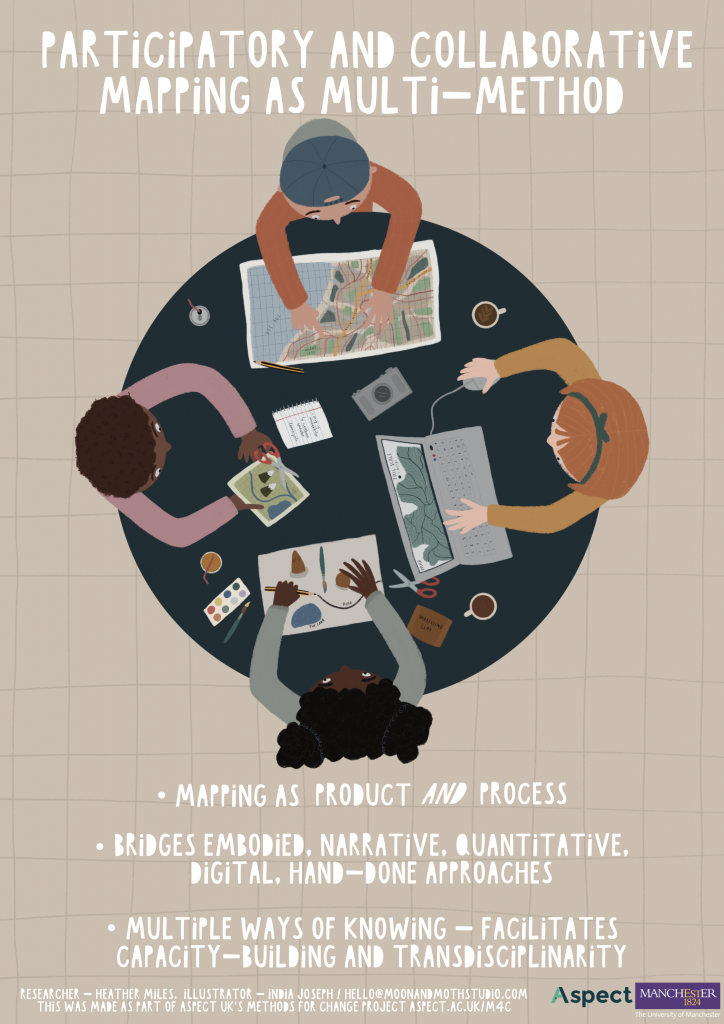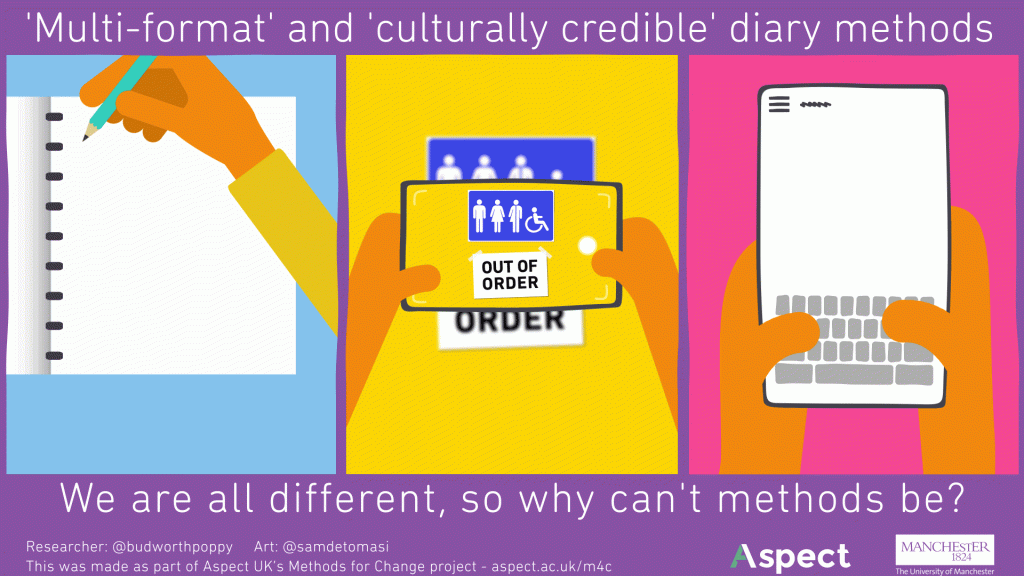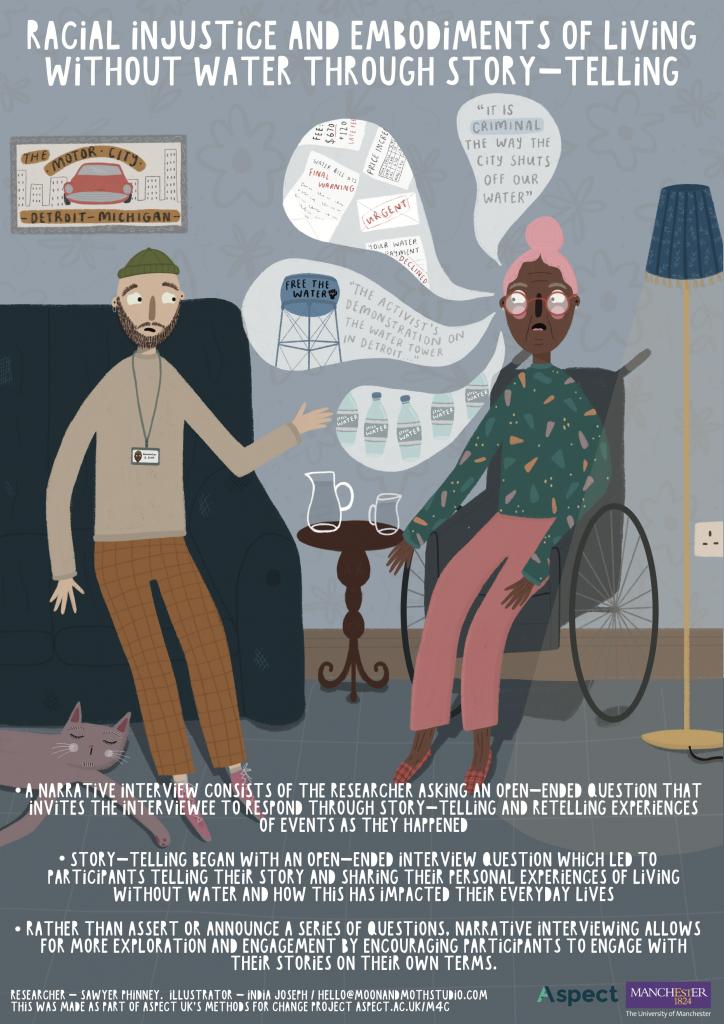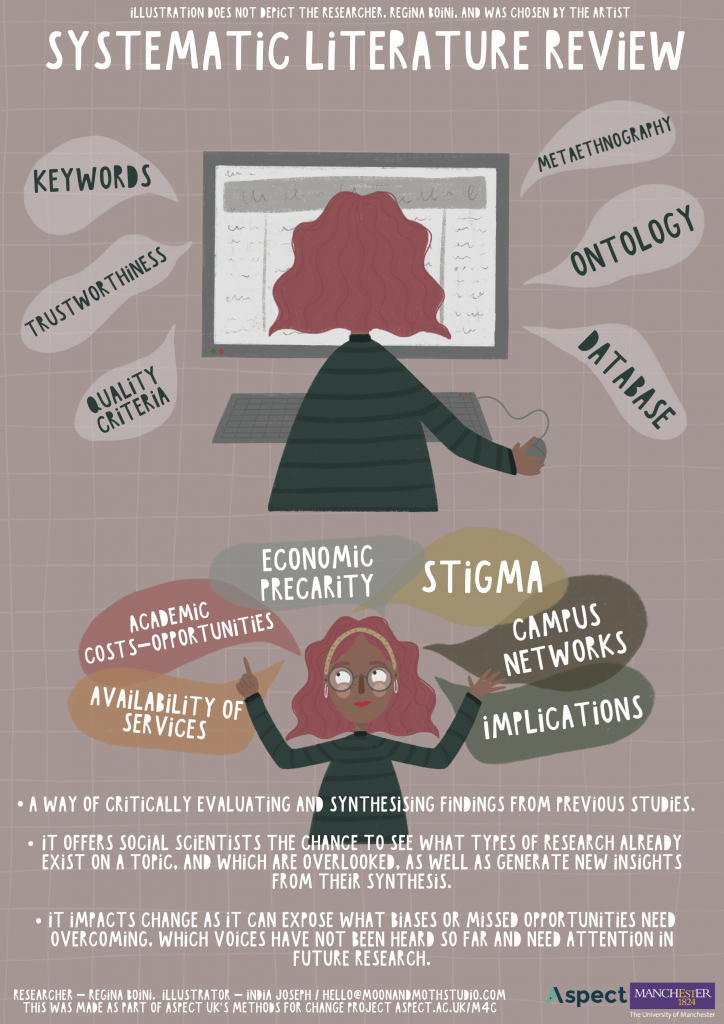As part of the Methods for Change Showcase event on 12 May 2021, postgraduate researchers using transformative social science methods were invited to create a poster about their chosen method. The Postgraduate Methods Gallery features six posters created by researchers from Aspect institutions about a fascinating range of social science methods and topics, including: Reimagining Diary Methods (Poppy Budworth), Narrative Interviewing (Sawyer Phinney), Systematic Review (Regina Boini), Community-based and process-oriented mapping practices (Heather Miles), Padlet as a way of doing diary methods during a pandemic (Juliet Ye), and storytelling in Water Security, Peace, and Fragility in Liberia: An African Ecofeminist Approach (Chantal V. Bright).
Here are the finished creative pieces and reflections…
In June 2020, each of the six poster gallery contributors were offered the opportunity to work with one of the Methods for Change artists – India Joseph, Samuel De Tomasi and Alastair Lomas to assemble a creative output to communicate their work beyond academia. In this blog, the researchers discuss the creative skills they have developed through collaboratively producing a creative piece, highlighting how the process has encouraged fresh thinking about research communication, further reflection on what the methods might be able to do, and ideas for how they could be used in future.
Heather Miles is a PhD researcher in Geography at the University of Manchester exploring Community-based and process-oriented mapping practice. Heather worked with illustrator India Joseph to produce an image conveying Participatory and Collaborative Mapping as Multi-method: conveying Participatory and Collaborative Mapping as Multi-method:

“India immediately had the idea of a bird’s eye illustration of a table around which a group are busy with different mapping activities. She also mocked up other formats such as a series of illustrations each showing different activities, but this bird’s eye view really seems to accentuate the tactility of the activities, with the materials and equipment spread over the table. This is further emphasised by the mappers’ hands spread out over them.“
“Prior to finalising the artwork I was also able to request other amendments as well as add some text. A creative mode of describing a creative method is of course particularly appropriate. The artwork really succinctly demonstrates a range of approaches that can be used together – much more informative than using text to explain the different mapping practices. This illustration will be so helpful in describing the method to potential research participants, for example. The experience has also encouraged me to consider how I could work with artists in the future to create visuals at different stages of research.“
Poppy Budworth is a PhD researcher in Human Geography at the University of Manchester, exploring Lived experiences of young ostomates: space, relationships and identity through an ESRC funded, qualitative and mixed-method research project. She reflects on how the experience of producing a GIF with designer Samuel De Tomasi prompted her to think differently about the potential advantages to using flexible diary methods:

“As well as understanding more about making creative outputs, co-designing the GIF allowed me to get to know the method more intimately. Discussing ‘multi-format’ and ‘culturally credible’ diary methods with Sam revealed the multiple advantages of adopting flexible methodologies. It became clear that such tasks could improve the research experience for people with individual skillsets and access needs, as well as enhancing the process for those who speak different languages, have caring responsibilities and/or people who lead very busy lifestyles. Furthermore, producing the creative output with Sam provided an excellent opportunity to communicate with a non-academic audience about the chosen method, and the research project more broadly.“
“The GIF we created is flexible in terms of audience suitability. The creative output can be used with participants to demonstrate how flexible diary methods look in practice, as well as in academic settings when introducing the methodological approach utilised in my PhD. Furthermore, sharing the gif on social media may encourage other Postgraduate Researchers who are interested in everyday life to bring imaginative, familiar and fluid methods into their research projects.“
Juliet Ye is a PhD researcher in Architecture at the University of Manchester. Her research, Transcultural life stories in everyday nature: the case of Chinese international students in Manchester uses Padlet as an online platform for remote ethnography. Working with visual anthropologist Alastair Lomas, Juliet created a video to explain how Padlet can be used:
Video communicating how to use Padlet by Juliet Ye, in collaboration with Alastair Lomas.
“During scriptwriting and shooting, I got to learn how to effectively showcase the flow and interactivity of the tool using my research design template, and really pinpoint the honeypots – why other social scientists and ethnographers should consider using it for their ethnography work. In the future I would expect to use this piece to introduce Padlet to my participants, and to connect to other researchers or professionals who are interested in the method as well. “
“Being a researcher with design backgrounds does smooth the process, but what really is key to the collaboration is to have a clear idea of what you want to convey about your method and what audience you wish to display this work to. As you communicate with the collaborator, you get the chance to have a second opinion (which is so precious) on what to present and how. As a non-native English speaker, I also found it very helpful to have someone condense and polish the scripts, which makes such a difference to the final product.“
Chantal V. Bright is a PhD researcher in Human Geography at the University of Manchester, researching Water Security, Peace, and Fragility in Liberia: An African Ecofeminist Approach. She reflects on the wider importance of creative methods in her work as both a researcher and a children’s book author, and notes the challenge of developing succinct and engaging messaging to communicate her research:
“As a children’s book author, it seemed like a natural approach for me to incorporate creative components as a part of my PhD research even though, I wasn’t initially aware that I could use creative methods in Geography. It was a challenge to determine what creative methods might look like for my research. I decided that I will use data captured through narratives, storytelling, and naturalistic observation and turn it into the third part of my children’s book series, Janjay—set in Liberia—the small West African country where my research is based.”
“Contributing to the Methods for Change Postgraduate Poster Gallery provided an opportunity to work with fellow postgraduate researcher and one of the Methods for Change artists, Alastair Lomas to produce my own creative output related to my research methods. From the offset, I had a clear idea of what sort of result I wanted. Instead of a still image or illustration, I thought it would be nice to create a short video. I discussed my vision with Alastair, and he was able to reimagine my idea. We decided to use illustrations from my book series and add a voiceover of me explaining my creative methods and how it all ties in with my research. It was a perfect touch to piece the film all together. Alastair was very professional, incredibly responsive, attentive to detail, and perhaps most importantly, pleasant to work with. During the process, I learned how to deliver my “elevator pitch” about my research. I realised that the visuals needed to compliment the explanation of my research, so I was challenged to deliver a concise messaging that would also be engaging. In the end, I was pleased with the outcome, and I feel confident that video will be easily accessed and understood.“
Collaborative working in the context of Covid restrictions requires creative thinking, as Alastair explains:
“Working remotely during a pandemic introduced some challenges in terms of materials that could be used and limited face-to-face contact – something that the researchers themselves are being forced to adapt to in their own work, too. Nevertheless, it has been a fantastic experience working with them to come up with creative solutions – creative research communication is great opportunity to collaborate on some really interesting projects.“
Sawyer Phinney is a PhD researcher in Human Geography at the University of Manchester whose work examines the intersections of race and racism, and urban austerity in U.S cities. They worked with illustrator, India Joseph to produce a visual illustration entitled Racial injustice and embodiments of living without water through story-telling, exploring narrative interview methods:

“Working with an artist to depict my method was intellectually rewarding by being able to share intimate moments with my participants in ways that I felt “moved” or “transformed” through the method when it was used. For example, I described to the artist a moment of interviewing an elderly single grandmother living without water, and hearing her powerful story changed my perspective of my research. I was amazed how my description of the event was so accurately illustrated by India in a way that brought life and light to this moment.“
“I learned that my research method of narrative story-telling was powerful in drawing connections from the participant to broader societal issues byallowing the space and time for participants to have their voice and share their struggles in a way that we all can relate to – what it means to survive and what injustice looks like. I would use my creative piece in the future with community organizations or other researchers who are interested in doing work with families or households and encourage them to use story-telling as a way to centre everyday experiences as important forms of knowledge production in research.“
Regina Boini, Counselling Psychologist in Professional Training at the University of Manchester, also worked with India Joseph to produced an image depicting Systematic Literature Review methods. The illustration highlights how this approach can critically evaluate and synthesise findings from previous studies, expose existing biases or missed opportunities, and help researchers understand which voices have not been heard so far and need attention in future research.

India and Samuel De Tomasi reflect on their experiences working with Postgraduate researchers as well as academic contributors across the wider Methods for Change project to share methods with diverse audiences:
India Joseph:
“It’s been interesting to see a range of creative outputs including film making, photography, collages and illustrations. It can be challenging initially to convey somebody else’s ideas, but with communication and trust, we’ve been able to produce some wonderful pieces. It’s rewarding to work in a collaborative environment to enhance the social science research methodologies.“
Samuel De Tomasi:
“It was great to collaborate with people from different backgrounds and fields who have really interesting ideas – especially when the research contributes to making the world a better place.”
Finally, the researchers offered this advice to academics thinking of producing a creative piece to communicate their work:
“I would highly recommend making a creative output to communicate research methods, especially working with an artist outside of your field; this has been a great experience to get to know my method better and to practice talking about my research in a different environment.” (Poppy Budworth)
“Too many times in academia we find that amazing research is conducted with the potential to make a real impact, however sometimes researchers lack the knowledge on how best to communicate their study to non-academic audiences. Even if creative methods do not seem possible in your field, consider creative ways to share data as this will expand the potential reach of your research. I challenge researchers to explore film, art, photography, or creative writing—just as I have—to showcase their work.” (Chantal V. Bright




